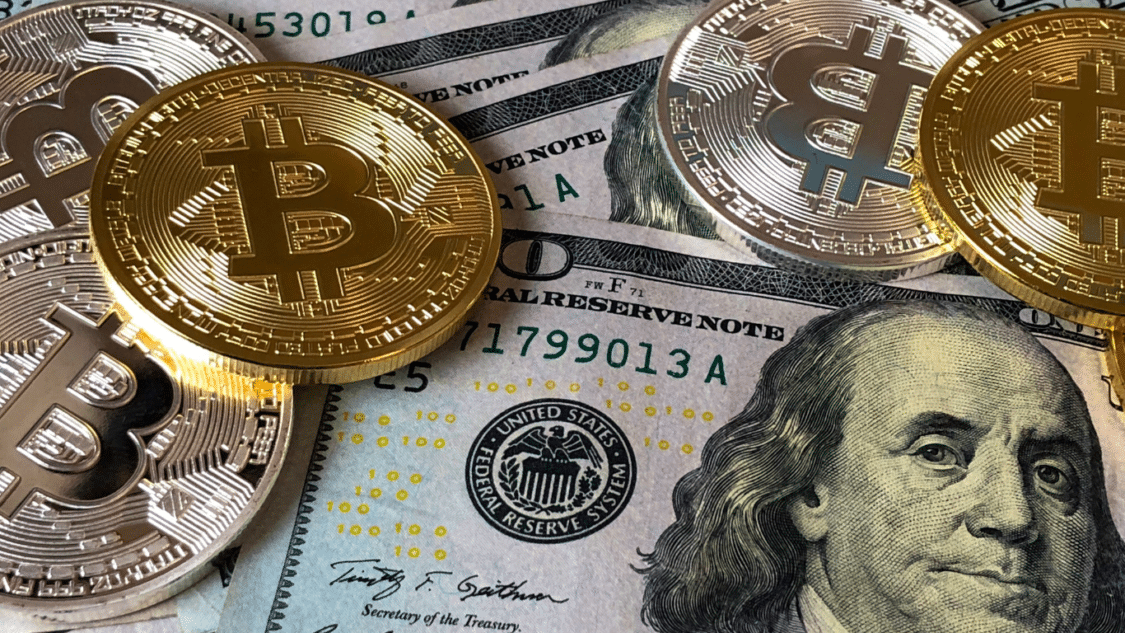This article will provide you with information all about stablecoins.We will talk about the importance of stablecoins, we will provide you with a list of stablecoins to enrich your knowledge.
A stablecoin is a crypto asset that is related to another asset. It doesn’t stand alone; an example is fiat currencies or precious metals. Its name represents the price stability that it holds. The notion behind stable coins is to maintain a stable price and avoid the volatility and risks of the crypto market.
Stablecoin vs Bitcoin
Stablecoins and Bitcoin are two of the most well-known cryptocurrencies in the market. While both are digital assets, some key differences set them apart.
Stablecoins, as the name suggests, are designed to maintain a stable value. the stabillity is achieved by pegging the stablecoin to a real-world asset or currency, such as the US dollar or gold. Because of that stablecoins are less volatile than other cryptocurrencies like Bitcoin, known for their price fluctuations.
One of the main benefits of stablecoins is their stability. Because stablecoins are pegged to a stable asset or currency, they provide a more predictable investment option than other cryptocurrencies.If you are looking for a stable investment stablecoins is your path.
Another benefit of stablecoins is their use in the broader cryptocurrency ecosystem. Stablecoins are more used as a means of payment or as collateral for decentralized finance (DeFi) applications. Because stablecoins are less volatile than other cryptocurrencies, they can be used as a reliable means of payment or collateral without worrying about price fluctuations.
On the other hand, Bitcoin is known for its volatility and price fluctuations. While Bitcoin has experienced significant growth and has become a popular investment option, it is also known for its high level of risk. Bitcoin’s price can be affected by various factors, including market sentiment, regulatory changes, and technological advancements.
Despite its volatility, Bitcoin has several advantages over stablecoins. One of the advantages of Bitcoin is its decentralization. Bitcoin works on a decentralized network, which means that any government or central authority does not control it. This makes Bitcoin a popular option for individuals looking for a currency not subject to government intervention or control.
Bitcoin also has a strong network effect. Bitcoin has been around for over a decade and has a large and active community of users and developers. This makes it easier for individuals to buy, sell, and trade Bitcoin, contributing to its widespread adoption.
Another advantage of Bitcoin is its scarcity. Bitcoin is limited to a max supply of 21 million coins, which makes it a lacking asset. This absence has contributed to its high value and has made it a popular investment option for individuals looking for an asset not subject to inflation.
Stablecoin list with disadvantages benefits
Stablecoins:
Pros:
- Stability: Stablecoins are designed to maintain a stable value, which makes them a predictable investment option.
- Use in cryptocurrency ecosystem: Stablecoins are often used as a means of payment or collateral for DeFi applications, as they are less volatile than other cryptocurrencies.
- Familiarity: Stablecoins are often pegged to real-world currencies or assets, which makes them more familiar to investors who are used to traditional investment options.
Cons:
- Limited upside potential: Stablecoins are designed to maintain a stable value, which means that their potential for growth is limited compared to other cryptocurrencies like Bitcoin.
- Counterparty risk: Some stablecoins are backed by a central authority, which means that there is a risk that the issuer could default on its obligations.
- Regulatory risk: Stablecoins could face regulatory challenges, as they blur the line between traditional finance and cryptocurrency.
Bitcoin:
Pros:
- Decentralization: Bitcoin operates on a decentralized network, which means that it is not subject to government intervention or control.
- Network effects: Bitcoin has a large and active community of users and developers, which makes it easier to buy, sell, and trade Bitcoin.
- Scarcity: Bitcoin is limited to a maximum supply of 21 million coins, which makes it a scarce asset and has contributed to its high value.
Cons:
- Volatility: Bitcoin is known for its price fluctuations, which makes it a high-risk investment option.
- Lack of stability: Bitcoin does not maintain a stable value, which makes it less predictable than stablecoins.
- Limited use: Bitcoin’s use as a means of payment is limited compared to stablecoins, which are often used as a means of payment or collateral for DeFi applications.
Types of stablecoins:
Fiat-backed, crypto-backed, and algorithmic are the three types of stable coins out there.For example stablecoin is BUSD which stands for Binance USD of a fiat-backed. These stabelcoins are pegged to the traditional fiat currency. DAI is an example of a crypto-backed stablecoin, and to factor in the volatility of cryptocurrencies, these stabelcoins over-collateralize their tokens. Algorithmic stablecoins regulate supply without involving reserves. As stablecoins have become practical for many traders and investors, regulators have begun to look deeper into them. Governments have also considered creating their own in order to gain control of the currency.
How is a stable coin connected to cryptocurrency?
Stablecoins are digital assets associated with the value of fiat currencies or, for that matter, any asset. An example would be just like buying tokens that are associated with the dollar, yen, euro, oil, and gold. A stablecoin allows you to hold the profits and losses and transfer the value at a stable price via peer-to-peer blockchain networks.
As we know, Bitcoin and Ether have always been volatile. Of course, people have been using these currencies for a long time, as it does have their advantages. However, volatility also brings challenges, whether it be for day-to-day payments or anything else.
Initially, there was no way for crypto investors and traders to lock in a profit or avoid volatility without converting crypto into fiat. Stablecoins provided a simple alternative for this problem. Today, you can freely enter and exit the crypto market using stablecoins such as BUSD or USDC.
All about Stablecoins – How do they work?
As we mentioned above, stablecoins are pegged to another asset. So how does the pegging work? Let’s discuss the most famous two types of stablecoins and the third type and how they are pegged.
Fiat backed

These stabelcoins keep a fiat currency like USD or GBP in reserves. Each BUSD, for example, is backed by a real US dollar held as collateral. Users can exchange fiat for stablecoins and vice versa at the set price. If the token’s fee differs from the underlying fiat, arbitrageurs will quickly bring it back to the original set rate.
If BUSD were trading for a dollar, arbitrageurs would turn the US dollar into BUSD, raise the price and sell it on the market. This, in turn, increases the supply of BUSD for sale and lowers the price to one dollar again. When the BUSD falls below one dollar, traders buy it and convert it to USD. This increases demand for the BUSD, causing its price to go back to one.
Crypto backed

Like fiat-backed stablecoins, crypto-backed stablecoins use cryptocurrencies as collateral instead of dollars or another currency. These stablecoins, by use of smart contracts, can manage the minting and burning. This is a more reliable and efficient process because users can control the contracts. There are crypto-backed stablecoins that Decentralized Autonomous Organizations run. In this case, the community can vote for any changes they want to see in the project. Or they can put their trust in the DAO to manage the project.
Algorithmic
This type of stablecoin stands apart from the first two. Algorithmic stablecoins don’t use reserves in place; they use algorithms and smart contracts. This is a pretty rare form of stablecoin and also happens to be less successful.
An algorithmic stablecoin system, in essence, reduces the token supply if the price falls below the fiat currency it measures. This could be achieved through locked staking, burning, or buy-backs. If the price exceeds the value of the fiat currency, new tokens are issued to reduce the value of the stablecoin.
How do stablecoins make you money?
Stablecoins can make you money in several ways. First, stablecoins can be used as a store of value or a medium of exchange. Because stablecoins are less volatile than traditional cryptocurrencies, they are a popular choice for traders and investors who want to reduce their exposure to market fluctuations. Holding stablecoins can also be a way to earn interest or rewards, as some platforms offer high-yield savings accounts or staking programs for stablecoin holders.
Stablecoins can also be used for trading and arbitrage. Because stablecoins are pegged to a stable asset or currency, they can quickly and easily transfer funds between different cryptocurrency exchanges or wallets. This is very useful for traders who want to manipulate price discrepancies or arbitrage opportunities between other markets.
Most stablecoins are used to access the benefits of cryptocurrencies without being exposed to their volatility. Stablecoins can be used to make purchases, send money across borders, or store value, without worrying about price fluctuations. Stablecoins are also popular for trading and investment purposes, as they can provide a more stable and predictable asset for investors to hold.
Stablecoins are also crucial for the broader cryptocurrency ecosystem. Stablecoins bridge the traditional financial system and the world of cryptocurrencies, making it easier for users to move funds from their crypto ecosystem. Stablecoins are also helpful for decentralized finance (DeFi) applications, which rely on stablecoins to provide liquidity and collateral for their platforms.
Examples of stablecoins
- Tether (USDT): Tether is the most widely used stablecoin pegged to the US dollar—actual reserves of USD and other assets back it.
- USD Coin (USDC): USD Coin is pegged to the US dollar. A mix of cash and some short-term US Treasury bonds backs it.
- Dai (DAI): Dai is pegged to the US dollar but is backed by a basket of cryptocurrencies rather than fiat currency. It is a decentralized stablecoin maintained by a network of users and is designed to be more stable than other cryptocurrencies.
- TrueUSD (TUSD): TrueUSD is pegged to the US dollar and is backed by US dollars held in escrow accounts.
- Paxos Standard (PAX): Paxos Standard is pegged to the US dollar and is backed by US dollars held in FDIC-insured banks.
These stablecoins can be used for various purposes, such as trading, payments, and as collateral for decentralized finance (DeFi) applications. They offer a stable and reliable alternative to other cryptocurrencies, which are often highly volatile.
What is circle stablecoin?
Circle is a fintech company that gives a suite of digital financial administrations, including a stablecoin called USD Coin (USDC). USDC could be a cryptocurrency pegged to the US dollar at a 1:1 proportion, implying that one USDC is continuously worth one US dollar. Circle propelled USDC in 2018 in association with Coinbase, one of the biggest cryptocurrency trades within the Joined together States.
USDC is an ERC-20 token, which suggests it is built on the Ethereum blockchain. This permits USDC to be utilized in various Ethereum-based applications, such as decentralized trades, loaning stages, and instalment systems. USDC is bolstered by several other blockchain stages, counting Algorand, Stellar, and Solana.
One of the key benefits of USDC is its soundness. Since it is pegged to the US dollar, USDC is less unstable than other cryptocurrencies like Bitcoin and Ether. This makes it a more solid alternative for businesses and people who ought to make exchanges or hold resources in steady cash. USDC also allows for quick and low-cost cross-border deals, which can be especially valuable for settlements and universal commerce.
In expansion to its steadiness, USDC is additionally sponsored by a savings of US dollars held in isolated bank accounts. This implies that for each USDC token issued, there’s a comparable sum of US dollars held in save. The saves are examined monthly by a third-party bookkeeping firm to guarantee that they coordinate the sum of USDC in circulation.
Circle has moreover executed a number of measures to guarantee the straightforwardness and judgment of USDC. For case, Circle gives normal attestations from its bank accomplices to confirm the sum of saves held. Circle also distributes a month-to-month report on the USDC save composition, which offers points of interest on the resources backing USDC.
Circle’s USDC stablecoin offers a solid and straightforward elective to other cryptocurrencies. Its solidness, speed, and low-cost exchanges make it an attractive choice for businesses and people who require steady cash for exchanges and resource capacity.
Conclusion
Stablecoins are an efficient way to make payments and transfers worldwide. In addition, they can also be used to earn passive income with staking in the Defi ecosystem. However, just like everything, they have their disadvantages as well. As versatile as they are in the crypto world, they are still considered a cryptocurrency and have similar risks.
Short Term and Long-Term Investments
Hot Wallets and Cold Wallets – Choosing The Best Crypto Wallet?

